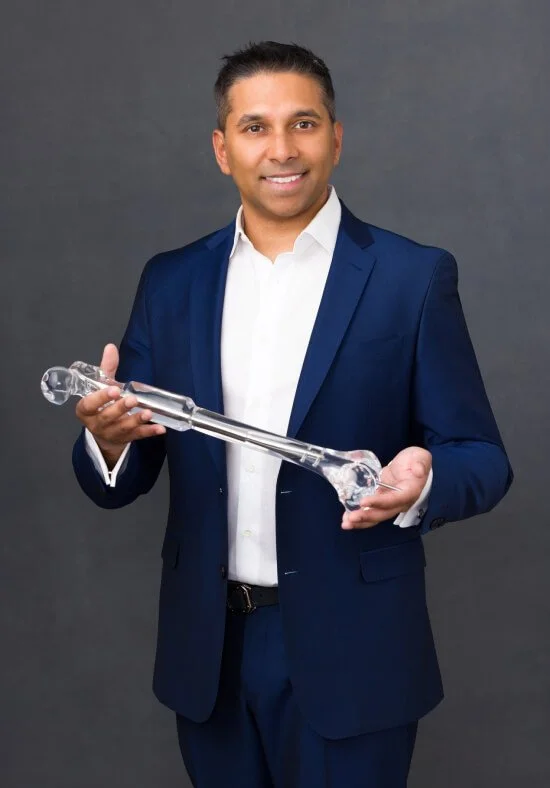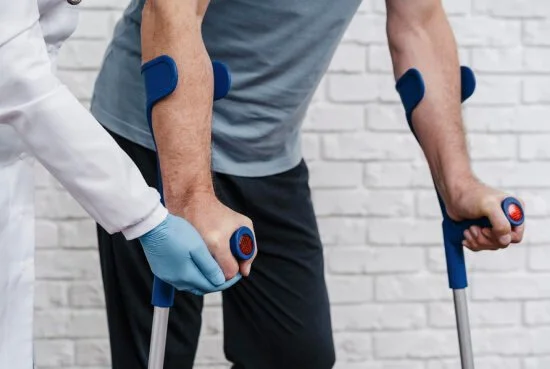LEG SHORTENING SURGERY
At Limbplastx Institute, our expertise lies in pioneering orthopedic procedures meticulously crafted to elevate the well-being of our patients. Among these innovative interventions, Leg Shortening Surgery stands out as a testament to our commitment to advancing orthopedic care. This procedure, meticulously performed by Dr. Kevin Debiparshad, addresses limb length inequality, a condition that can profoundly impact mobility and daily function, and is a very popular procedure in the transgender population.
Through precise adjustments and state-of-the-art techniques, we aim not only to equalize limb lengths but also to empower individuals with improved mobility, reduced discomfort, and enhanced overall quality of life. Our dedication to excellence and patient-centered care drives us to continually push the boundaries of orthopedic innovation, ensuring that each patient receives the highest standard of treatment and support at Limbplastx Institute.
LIMB SHORTENING SURGERY
Limb shortening surgery, also known as leg shortening surgery or limb length discrepancy correction, is a medical procedure to correct significant differences in the lengths of a person's limbs. This condition can occur due to various reasons, such as congenital anomalies, growth plate injuries, or diseases like polio. While a slight difference in limb length is common and often doesn't require intervention, significant differences can lead to gait abnormalities, joint pain, and spinal issues.
Indications for Leg Shortening Surgery
Leg shortening surgery is a specialized procedure typically reserved for individuals grappling with significant limb length discrepancies (LLD). These discrepancies, often noticeable imbalances in leg lengths, can stem from various underlying factors, each presenting unique challenges and considerations for surgical intervention. Here's an in-depth exploration of the diverse indications for leg shortening surgery:
Congenital Conditions
Hemihypertrophy - This congenital abnormality involves one side of the body growing disproportionately larger than the other. In cases where the affected limb is longer, it can result in a noticeable LLD. Leg shortening surgery may be considered to correct this asymmetry and restore balance to the individual's physique and gait.
Trauma
Bone Diseases
Skeletal Dysplasia
Severe Fractures - Traumatic injuries, particularly those affecting the growth plates during childhood, can disrupt the natural growth process of the bone. When a fracture impairs proper growth in one limb, it can lead to stunted development and a noticeable discrepancy in leg lengths.
Growth Plate Injuries - Damage to the growth plates responsible for longitudinal bone growth can result in uneven limb lengths as the affected bone fails to grow at the same rate as its counterpart. Leg shortening surgery may be considered to address the resulting LLD and restore symmetry to the lower limbs.
Osteochondroma - This benign bone tumor can develop near the growth plates, potentially impeding proper bone growth and leading to a noticeable LLD.
Osteomyelitis - This infectious condition affecting the bone can disrupt normal bone growth and development, contributing to LLD in affected individuals. Leg shortening surgery may be indicated to address the resultant imbalance and functional limitations.
Achondroplasia - As the most common form of dwarfism, achondroplasia is characterized by disproportionately short limbs. While limb lengthening procedures are more frequently associated with this condition, certain cases may warrant leg shortening surgery to achieve better balance and alignment in the lower extremities.
In each scenario, the underlying cause of the limb length discrepancy informs the decision-making process regarding the appropriateness of leg shortening surgery. By addressing the root cause of the imbalance and tailoring surgical interventions to individual patient needs, healthcare providers strive to optimize outcomes and improve the overall quality of life for individuals facing this challenging condition.
Types of Limb Shortening Surgery
Types of limb shortening surgery can vary depending on the individual patient's specific needs, the severity of the limb length discrepancy (LLD), and the underlying cause of the condition. Here are some of the main types of limb shortening procedures:
Epiphysiodesis
Also known as growth plate arrest, epiphysiodesis is a minimally invasive surgical procedure commonly performed in children and adolescents whose bones are still growing. During this procedure, the growth plate (epiphysis) of the longer limb is intentionally damaged or removed, halting further growth and allowing the shorter limb to catch up over time. Epiphysiodesis is often preferred for patients with mild to moderate LLD and those nearing skeletal maturity.
Physeal Bar Resection
Similar to epiphysiodesis, physeal bar resection involves removing or excising a portion of the growth plate to stunt the growth of the longer limb. However, unlike epiphysiodesis, which disrupts the growth plate's function without removing bone tissue, physeal bar resection entails removing the abnormal growth plate or "bar" that inhibits normal bone growth. This procedure is typically reserved for patients with more severe LLD or those with skeletal dysplasia.
Epiphysiodesis with Shortening
In cases where the limb length discrepancy is significant and requires more aggressive intervention, surgeons may combine epiphysiodesis with bone shortening. This approach involves both arresting growth in the longer limb and surgically shortening the bone to achieve a more balanced limb length. Epiphysiodesis with shortening is commonly performed in children with congenital conditions or developmental abnormalities affecting bone growth.
Osteotomy
Osteotomy is a surgical procedure that involves cutting and repositioning bone segments to achieve the desired length and alignment. In limb shortening surgery, osteotomy may be performed on the longer bone(s) of the leg(s) to remove a segment of bone and reduce overall length. This technique allows for precise adjustment of limb length and alignment and is often used in adults or adolescents with completed skeletal growth.
Ilizarov Technique
The Ilizarov method, named after the Russian orthopedic surgeon Gavriil Ilizarov, is a specialized limb lengthening and shortening technique that utilizes external fixation devices. In cases of limb shortening, the Ilizarov technique involves cutting the bone(s) and gradually compressing the bone ends using external fixators over a period of weeks or months. This gradual compression stimulates bone healing and remodeling, allowing for controlled shortening of the limb.
Intra-articular Shortening
Intra-articular shortening involves removing a segment of bone from within a joint, typically the knee or hip, to shorten the overall length of the limb. This technique may be indicated for patients with LLD resulting from joint abnormalities or deformities affecting the length of the bone within the joint.
Each type of limb shortening surgery has its advantages and considerations, and the choice of procedure depends on factors such as the patient's age, skeletal maturity, severity of LLD, underlying pathology, and surgical goals. A thorough evaluation by a multidisciplinary team of orthopedic surgeons, pediatricians, physiatrists, and rehabilitation specialists is essential to determine the most appropriate treatment approach for each individual patient.
Surgical Procedure
The surgical procedure for leg shortening, also known as limb length reduction, is a meticulous process aimed at rectifying discrepancies in leg length, which can lead to issues with height, gait, and overall physical appearance. It typically involves several key steps:
1. Preoperative Evaluation: Before proceeding with surgery, a comprehensive evaluation is conducted. This includes a thorough review of the patient's medical history, a physical examination, and the performance of imaging studies such as X-rays or CT scans. During this stage, the patient and their medical team engage in detailed discussions regarding the goals and expectations of the surgery.
2. Anesthesia: The surgery itself is performed under general anesthesia to ensure the patient remains comfortable and pain-free throughout the procedure. Anesthesia also helps to maintain the patient's safety by keeping them unconscious and immobile during the operation.
3. Bone Resection: The surgeon makes precise incisions at predetermined sites along the longer bone(s) of the leg(s), typically the femur or tibia. Using specialized instruments, they carefully remove a segment of bone to achieve the desired shortening. This step requires meticulous attention to detail to ensure the correct amount of bone is removed to address the leg length discrepancy.
4. Soft Tissue Management: In addition to bone resection, the surgeon may need to address soft tissue structures such as muscles, tendons, and ligaments. This is crucial for ensuring proper alignment and function of the leg following the shortening procedure. Any soft tissue deformities or abnormalities contributing to the leg length inequality may be corrected during this phase of the surgery.
5. Closure: Once the necessary adjustments have been made to the bone and soft tissues, the surgeon meticulously closes the incisions using sutures or staples. Dressings are then applied to the surgical site to promote healing and minimize the risk of infection.
Post-operative care and rehabilitation play crucial roles in the success of leg shortening surgery. Patients are closely monitored during the initial recovery period to manage pain, prevent complications, and ensure proper healing of the surgical site. Physical therapy and rehabilitation exercises are typically prescribed to help restore strength, flexibility, and mobility to the affected leg.
Follow-up consultations with the doctor are scheduled to track progress, address any concerns or complications, and adjust the treatment plan as needed. Overall, leg shortening surgery requires careful planning, precise execution, and comprehensive post-operative care to achieve optimal outcomes and improve the quality of life for affected individuals.
Recovery and Rehabilitation
The recovery process following leg shortening surgery is crucial for ensuring successful outcomes and optimizing the patient's quality of life. Given the complexity of the procedure and the potential impact on mobility and function, rehabilitation plays a pivotal role in helping patients regain strength, mobility, and confidence in their affected limbs. Here's an expanded overview of the recovery process:
1. Immobilization: Following surgery, patients often require a period of immobilization to allow the surgically altered bones and soft tissues to heal properly. This may involve the use of crutches, walkers, or wheelchairs to minimize weight-bearing on the operated leg(s) and prevent undue stress on the healing tissues. In some cases, external fixation devices, such as frames or braces, are employed to stabilize the limbs and maintain proper alignment during the initial healing phase.
2. Physical Therapy: Once the surgical team clears the patient, they begin a structured physical therapy program tailored to their needs and recovery goals. Physical therapists work closely with patients to restore strength, flexibility, and range of motion in the affected leg(s) through targeted exercises and modalities. These may include gentle stretching exercises, resistance training, and functional activities to improve balance, coordination, and overall mobility. Physical therapy sessions gradually progress as the patient's healing progresses, aiming to maximize functional outcomes and minimize long-term complications.
3. Follow-up Care: Regular follow-up appointments with the surgical team are essential for monitoring the patient's progress and addressing any concerns or complications that may arise during the recovery process. These appointments provide an opportunity for the surgical team to assess healing, evaluate range of motion and function, and make any necessary adjustments to the rehabilitation plan. Close communication between the patient, surgical team, and physical therapists is key to ensuring optimal outcomes and addressing any issues that may arise.
4. Gradual Return to Activities: As the patient's strength, mobility, and confidence improve, they gradually return to their normal daily activities and routines. This may involve progressively increasing weight-bearing activities, such as walking and standing, under the surgical team's and physical therapist's guidance. Patients are encouraged to listen to their bodies and pace themselves accordingly, taking breaks and modifying activities to avoid overexertion or injury.
It's important to note that the recovery process following leg shortening surgery can vary significantly depending on the extent of the procedure, the patient's overall health and fitness level, and any underlying medical conditions. While some patients may experience a relatively smooth recovery with few complications, others may encounter challenges such as delayed healing, infections, or under-correction of the leg lengthening difference.
Close adherence to post-operative instructions, diligent rehabilitation efforts, and ongoing communication with the medical team is essential for maximizing the chances of a successful outcome and restoring optimal function and mobility to the affected limb(s).
Risks and Complications
Leg shortening surgery, while offering significant benefits in correcting limb length differences and associated deformities, is not without risks and potential complications. Understanding these risks is crucial for patients considering this procedure and their healthcare providers. Here are some of the potential risks and complications:
1. Infection: Infections can occur at the incision sites or within the bone, leading to complications such as inflammation, delayed healing, and the possibility of more severe systemic infections. Proper surgical techniques, sterile procedures, and post-operative care are essential in minimizing this risk.
2. Delayed Healing or Nonunion: Some patients may experience delays in bone healing or nonunion, where the cut bone fails to heal properly. This may necessitate additional interventions such as bone grafting or the use of specialized devices to stimulate bone growth.
3. Nerve or Blood Vessel Damage: The intricate nature of leg shortening surgery poses a risk of injury to nearby nerves or blood vessels. Damage to these structures can result in sensory changes, numbness, circulation problems, or even more severe complications requiring further medical intervention.
4. Joint Stiffness or Instability: Altering the length of the leg(s) can impact joint mechanics and stability. Patients may experience stiffness, weakness, or instability in the affected joints, affecting their range of motion and ability to perform daily movements. Physical therapy and rehabilitation exercises are essential in addressing these issues and restoring optimal joint function.
5. Cosmetic Concerns: While the primary goal of leg shortening surgery is functional improvement, some patients may have cosmetic concerns about the appearance of their legs post-operatively. This could include differences in leg length, shape, or alignment. Patient expectations should be carefully managed through thorough consultation and discussion of potential outcomes.
6. Under-correction or Over-correction: Achieving the desired limb length and alignment can be complex, and there is a possibility of under-correction or over-correction. Under-correction may necessitate additional surgery to achieve the desired outcome, while over-correction can lead to its own set of complications, including gait abnormalities and joint issues.
7. Other Potential Complications: Depending on individual health factors and the complexity of the surgery, patients may also face risks such as arthritis, muscle weakness, scoliosis, and deformities in other areas of the body, such as the hips, ankles, or feet. Complications related to the surgical hardware, such as screws, wires, or external fixation devices, may also arise, including loosening, migration, or breakage.
Patients considering leg shortening surgery should undergo a thorough preoperative evaluation, including diagnosis, discussion of potential risks and benefits, and consultation with a specialized healthcare team. Close monitoring and follow-up care are essential in managing potential complications and optimizing outcomes. Patients can make informed decisions about their healthcare journey by weighing the risks and benefits and exploring all available lengthening treatment options.
CONCLUSION:
Leg shortening surgery is a highly specialized procedure that enhances the quality of life for individuals grappling with considerable limb length inequality. This surgery promises to rectify asymmetry, reinstating equilibrium in the lower extremities. Addressing this deformity mitigates discomfort and fosters improved mobility and overall functionality. To ensure favorable outcomes and mitigate risks, patients must undergo comprehensive evaluations, grasp the potential benefits and drawbacks, and diligently adhere to postoperative directives. Collaboration among patients, surgical teams, and rehabilitation specialists is paramount for maximizing the efficacy of this intervention, as is the case with any surgical endeavor.
Life-Changing Leg Shortening Surgery at Limbplastx Institute
At Limbplastx Institute in Las Vegas, Nevada, we specialize in providing life-changing solutions for individuals facing discomfort and mobility challenges resulting from significant limb length discrepancies. Our experienced surgeons are dedicated to helping you regain confidence and mobility through leg shortening surgery. By addressing the root cause of your discomfort, we can improve your quality of life and help you achieve a more balanced and fulfilling future. Take the first step towards a brighter tomorrow by contacting us today to schedule a consultation.
Don't let LLD hinder your potential any longer. Contact Limbplastx Institute today at (702) 438-8255 and embark on your journey towards a better, more confident you!








